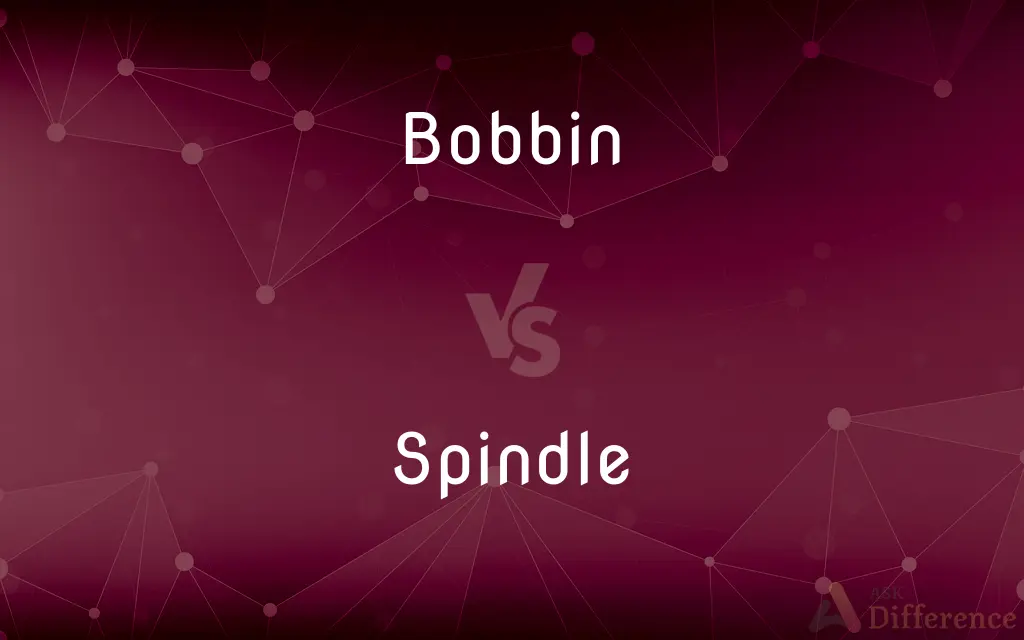Bobbin vs. Spindle — What's the Difference?
By Tayyaba Rehman & Urooj Arif — Updated on April 23, 2024
Bobbin refers to a cylinder or cone holding thread, yarn, or wire, used in sewing machines, whereas a spindle is a shaft used to spin fibers into thread.

Difference Between Bobbin and Spindle
Table of Contents
ADVERTISEMENT
Key Differences
A bobbin is typically made of plastic, metal, or wood, and is designed to hold thread, yarn, or wire tightly wound, especially in the context of textiles and sewing machines. In contrast, a spindle is a straight rod, usually made of wood, metal, or plastic, that is used primarily in hand-spinning fibers into yarn. It functions by twisting the fibers together through the spinning motion.
Bobbin is crucial in machines like sewing machines, where it feeds the thread in a controlled manner to aid in stitching. On the other hand, a spindle is essential in the traditional and manual process of turning loose fibers, such as wool or cotton, into continuous strands of yarn or thread.
In the use of a bobbin, the winding mechanism is key, as it ensures that the thread is evenly distributed across the bobbin, avoiding tangles and providing a smooth feed during the sewing process. Meanwhile, the spindle uses techniques like drop-spinning or supported spinning, where gravity or hand motion twist fibers into yarn.
Modern uses of bobbins are often found in sewing machines, embroidery machines, and weaving looms, highlighting its role in mechanized textile production. Spindles, while still used in handcrafting textiles, represent a more traditional and artisanal approach to yarn-making.
The design of a bobbin is such that it fits into specific mechanisms within machines, often requiring precise dimensions and compatibility specific to the machine model. Spindles, however, are more universal in design and can be used across different traditional spinning practices without the need for machine-specific adaptations.
ADVERTISEMENT
Comparison Chart
Material
Often plastic, metal, or wood
Commonly wood, but also metal or plastic
Usage
Holds thread in sewing machines
Twists fibers into yarn manually
Mechanism
Winding to distribute thread evenly
Uses spinning motion to twist fibers
Application
Sewing machines, weaving looms
Hand spinning, traditional textile crafts
Design Requirement
Specific to machine compatibility
Generally universal, adaptable to technique
Compare with Definitions
Bobbin
A small spool or reel on which yarn or thread is wound, used especially in sewing machines.
The bobbin in her sewing machine needed to be refilled with more thread.
Spindle
A tool used in hand-spinning to twist and wind fibers into yarn.
She used a wooden spindle to spin the raw cotton into fine thread.
Bobbin
A component in machinery that ensures the controlled feed of thread into the sewing process.
After replacing the bobbin, her machine ran smoothly without any thread jams.
Spindle
Can be used in various spinning techniques like drop-spinning.
The spindle dropped smoothly, twisting the fibers as it spun.
Bobbin
A cylinder or cone that holds thread, yarn, or wire, often used in textile machines.
She checked the bobbin to ensure there was enough yarn for her weaving project.
Spindle
Represents a universal tool in yarn production across cultures.
Spindles have been used worldwide for thousands of years in yarn making.
Bobbin
Essential for stitch formation in mechanized sewing.
A full bobbin is crucial for long uninterrupted sewing sessions.
Spindle
Often associated with traditional textile making.
Traditional artisans often demonstrate the use of a spindle at cultural heritage museums.
Bobbin
Often specific to the type of sewing machine used.
Each model of sewing machine requires a different type of bobbin.
Spindle
A slender rounded rod with tapered ends used in hand spinning to twist and wind thread from a mass of wool or flax held on a distaff.
Bobbin
A bobbin is a spindle or cylinder, with or without flanges, on which wire, yarn, thread or film is wound. Bobbins are typically found in sewing machines, cameras, and within electronic equipment.
Spindle
A rod or pin serving as an axis that revolves or on which something revolves.
Bobbin
A spool or reel that holds thread or yarn for spinning, weaving, knitting, sewing, or making lace.
Spindle
A slender mass of microtubules formed when a cell divides. At metaphase the chromosomes become attached to it by their centromeres before being pulled towards its ends.
Bobbin
Narrow braid formerly used as trimming.
Spindle
A Eurasian shrub or small tree with slender toothed leaves and pink capsules containing bright orange seeds. Its hard timber was formerly used for making spindles.
Bobbin
A spool or cylinder around which wire is coiled.
Spindle
A rod or pin, tapered at one end and usually weighted at the other, on which fibers are spun by hand into thread and then wound.
Bobbin
In a sewing machine, the small spool that holds the lower thread.
Wind the bobbin, place it in the machine, and raise the thread.
Spindle
A similar rod or pin used for spinning on a spinning wheel.
Bobbin
The little rounded piece of wood at the end of a latch string, which is pulled to raise the latch.
Spindle
A pin or rod holding a bobbin or spool on which thread is wound on an automated spinning machine.
Bobbin
(haberdashery) A fine cord or narrow braid.
Spindle
Any of various mechanical parts that revolve or serve as axes for larger revolving parts, as in a lock, axle, phonograph turntable, or lathe.
Bobbin
A small pin, or cylinder, formerly of bone, now most commonly of wood, used in the making of pillow lace. Each thread is wound on a separate bobbin which hangs down holding the thread at a slight tension.
Spindle
A spike on which papers may be impaled.
Bobbin
A spool or reel of various material and construction, with a head at one or both ends, and sometimes with a hole bored through its length by which it may be placed on a spindle or pivot. It is used to hold yarn or thread, as in spinning or warping machines, looms, sewing machines, etc.
Spindle
A baluster.
Bobbin
The little rounded piece of wood, at the end of a latch string, which is pulled to raise the latch.
Spindle
(Biology) A cytoplasmic network composed of microtubules along which the chromosomes are distributed during mitosis and meiosis.
Bobbin
A fine cord or narrow braid.
Spindle
(Anatomy) See muscle spindle.
Bobbin
A cylindrical or spool-shaped coil or insulated wire, usually containing a core of soft iron which becomes magnetic when the wire is traversed by an electrical current.
Spindle
Coastal New Jersey See dragonfly.
Bobbin
A winder around which thread or tape or film or other flexible materials can be wound
Spindle
To furnish or equip with a spindle or spindles.
Spindle
To impale or perforate on a spindle
Do not fold, spindle, or mutilate this card.
Spindle
To grow into a thin, elongated, or weak form.
Spindle
(spinning) A rod used for spinning and then winding natural fibres (especially wool), usually consisting of a shaft and a circular whorl positioned at either the upper or lower end of the shaft when suspended vertically from the forming thread.
Spindle
A rod which turns, or on which something turns.
The spindle of a vane
Spindle
A rotary axis of a machine tool or power tool.
Spindle
Certain of the species of the genus Euonymus, originally used for making the spindles used for spinning wool.
Spindle
An upright spike for holding paper documents by skewering.
Spindle
The fusee of a watch.
Spindle
A long and slender stalk resembling a spindle.
Spindle
A yarn measure containing, in cotton yarn, 15,120 yards; in linen yarn, 14,400 yards.
Spindle
(geometry) A solid generated by the revolution of a curved line about its base or double ordinate or chord.
Spindle
Any marine univalve shell of the genus Tibia; a spindle stromb.
Spindle
Any marine gastropod with a spindle-shaped shell formerly in one of the three invalid genera called Fusus.
Spindle
(biology) A cytoskeletal structure formed during mitosis
Spindle
(coastal New Jersey) a dragonfly, calque of Swedish slända (dragonfly/spindle), introduced by New Sweden settlers.
Spindle
(computing) A plastic container for packaging optical discs. Bulk blank CDs, DVDs, and BDs are often sold in such a package.
Spindle
A muscle spindle.
Spindle
(transitive) To make into a long tapered shape.
Spindle
(intransitive) To take on a long tapered shape.
Spindle
(transitive) To impale on a device for holding paper documents.
Do not fold, spindle or mutilate this document.
Spindle
The long, round, slender rod or pin in spinning wheels by which the thread is twisted, and on which, when twisted, it is wound; also, the pin on which the bobbin is held in a spinning machine, or in the shuttle of a loom.
Spindle
A slender rod or pin on which anything turns; an axis; as, the spindle of a vane.
Spindle
The shaft, mandrel, or arbor, in a machine tool, as a lathe or drilling machine, etc., which causes the work to revolve, or carries a tool or center, etc.
Spindle
The fusee of a watch.
Spindle
The vertical rod on which the runner of a grinding mill turns.
Spindle
A long and slender stalk resembling a spindle.
Spindle
A shaft or pipe on which a core of sand is formed.
Spindle
A yarn measure containing, in cotton yarn, 15,120 yards; in linen yarn, 14,400 yards.
Spindle
A solid generated by the revolution of a curved line about its base or double ordinate or chord.
Spindle
Any marine univalve shell of the genus Rostellaria; - called also spindle stromb.
Spindle
To shoot or grow into a long, slender stalk or body; to become disproportionately tall and slender.
It has begun to spindle into overintellectuality.
Spindle
(biology) tiny fibers that are seen in cell division; the fibers radiate from two poles and meet at the equator in the middle;
Chromosomes are distributed by spindles in mitosis and meiosis
Spindle
Any of various rotating shafts that serve as axes for larger rotating parts
Spindle
A stick or pin used to twist the yarn in spinning
Common Curiosities
Are bobbins universal?
Bobbins are not universal; they often need to match specific sewing machine models and types.
Is one better than the other for making yarn?
Spindles offer a traditional, hands-on approach to yarn making, while bobbins are part of a mechanized process.
Can a spindle be used in a sewing machine?
No, a spindle is not used in sewing machines; it is a manual tool for spinning fibers into yarn.
What is a bobbin used for in sewing machines?
A bobbin is used to hold thread in sewing machines, helping to form stitches as the machine sews.
How does a spindle work?
A spindle works by twisting fibers together as it spins, manually forming yarn.
What materials are spindles made from?
Spindles are usually made from wood, but can also be found in metal or plastic variants.
Do spindles require maintenance?
Spindles require minimal maintenance, primarily keeping them clean and ensuring they spin freely.
Can I use any spindle for any kind of fiber?
Yes, spindles can generally be used with different types of fibers, but some are better suited for certain fibers than others.
How do I choose the right bobbin for my sewing machine?
Check your sewing machine’s manual or manufacturer’s recommendations to choose the correct bobbin.
Why might someone choose to use a spindle over a sewing machine?
Someone might choose a spindle for the traditional craft and control over yarn characteristics.
How does the design of a bobbin affect its function?
The design of a bobbin affects thread tension and distribution, crucial for effective stitching.
What materials are bobbins made from?
Bobbins can be made from plastic, metal, or wood, depending on the sewing machine requirements.
Is it difficult to learn to spin with a spindle?
Spinning with a spindle can have a learning curve, but many find it a rewarding manual skill.
Can a bobbin be refilled?
Yes, bobbins can be refilled with thread as needed for continuous sewing.
What is the main advantage of using a bobbin in sewing?
B
Share Your Discovery

Previous Comparison
Wad vs. Waid
Next Comparison
Bet vs. BitAuthor Spotlight
Written by
Tayyaba RehmanTayyaba Rehman is a distinguished writer, currently serving as a primary contributor to askdifference.com. As a researcher in semantics and etymology, Tayyaba's passion for the complexity of languages and their distinctions has found a perfect home on the platform. Tayyaba delves into the intricacies of language, distinguishing between commonly confused words and phrases, thereby providing clarity for readers worldwide.
Co-written by
Urooj ArifUrooj is a skilled content writer at Ask Difference, known for her exceptional ability to simplify complex topics into engaging and informative content. With a passion for research and a flair for clear, concise writing, she consistently delivers articles that resonate with our diverse audience.














































